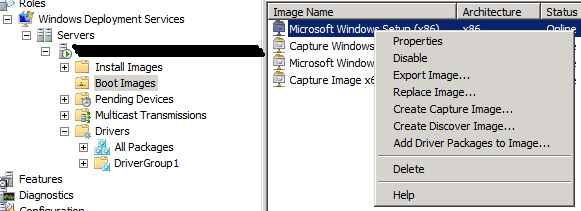
Adding Drivers To Windows Deployment Services
Hello, I am planning on using WDS to deploy Windows 7/64 images to a range of Dell systems – primarily Latitude, OptiPlex, and Precision. I have used this method on a small number of Latitude E6520’s with good results – after some effort. It’s been a few months since I did this, but in that case I believe I downloaded individual drivers from the Dell site, installed them on an E6520, copied the resultant driver install folders to the WDS server and imported them into the WDS driver store to be available to whatever imaging operation might need them. My first question is: Is it possible to download a complete driver bundle/package for a given Dell system such that the drivers don’t need to be downloaded piecemeal? I’ve seen traffic on the web about downloading from the Dell Enterprise Technology Center at the following link - which would seem to provide the solution. However, back when I was doing the initial deployment to a handful of E6520s I tried using drivers from this site but there seemed to be an issue with the drivers being unsigned. Second Question: Can someone confirm for me whether all drivers from this site are signed?
Feb 02, 2016 I'm trying to add a driver for the Killer 2200 network card to my Windows 10. Adding driver to WDS boot image. Microsoft Windows Deployment Services Review it.
Last Question: Does anyone who has used Microsoft WDS for image deployment to Dell systems have any recommendations regarding the handling of drivers? Custom ai droid english story translations. Hello, I don't know of any other way than piecemeal download. As far as the second question goes I believe that depends on how old the drivers are.
Now for the last question, there is a product out there that packages up all of the drivers for deployment. You can read more about it, but essentially they take all the headache out of downloading drivers and sorting through a finding which driver for which machine it does it for you. The product name is SmartDeploy Enterprise and it works hand in hand with WDS. You can download it for a trial. Hope this helps. Sidmvl – thank you for your response. Not really wanting to go to involve another deployment product, if possible, I did the following; After a bit more investigation I found the Dell driver CAB file for the Latitude E6520 on the standard drivers download page (under the Systems Mangement sub-category).
I downloaded this CAB, extracted drivers using CABARC.exe and imported these into their own driver group in WDS. I configured the driver group with no filters, simply letting whatever PnP device that needs a driver look for one. I then disabled all other driver groups on the WDS server so that only these would be available. I happened to have two fresh, out of the box, Latitude E6520’s on hand. I deleted the Dell Recovery partition and C: partition on one system, performed a PXE boot to the WDS server, and selected a generic Win 7/64 Enterprise install image. At the conclusion of the install, after stepping through the OOBE screens, I went to Device Manager and had a look.
The good news is that there were no yellow bangs. For comparison I set that E6520 to the other unit (still factory fresh) to do a side by side Device Manager comparison. Bully 5025 save game android.

A while back, I posted an article on building a SharePoint development environment in Hyper-V, which included a part on. Although we’ve now moved to VMware Workstation, we still use this approach for automating deployment of our standard Windows 7 builds, and this commentary is generally relevant to any Windows Deployment Services (WDS) deployment. When I learned WDS and the Windows Automated Installation Kit (which were both quite new in Windows Server 2008 R2 at the time), I contented myself with getting ~90% of the way to a fully-automated build, as the additional effort to get from 90 to 100% (mostly re: drivers) wouldn’t have paid enough immediate dividends and we needed to start capitalising on some of the other wins of our new environment.
As is often the case, we never got back to that remaining 10%, but it’s become more of an issue in recent months, as we’ve added a few Dell Latitude E6410 and Lenovo W520 laptops – both of which had network drivers that the Windows 7/Windows Server 2008 R2 boot images didn’t recognise. Unfortunately the TechNet guidance on adding drivers to boot images is unclear (to me anyway), so I’m contributing this quick post to attempt to clarify the problem that we had and the simple step-by-step solution. A matching network card driver was not found in this image After preparing our image with current patches and making the state as general-purpose as possible, we ran SysPrep with Generalise and OOBE, then Shut Down the machine. I always Shut Down rather than rebooting because I don’t want to miss the window in which I need to hit F12 to trigger the PXE boot to capture the image. If the post-SysPrep boot initiates there’s a risk that the SysPrep rearm count will be incremented, which is.